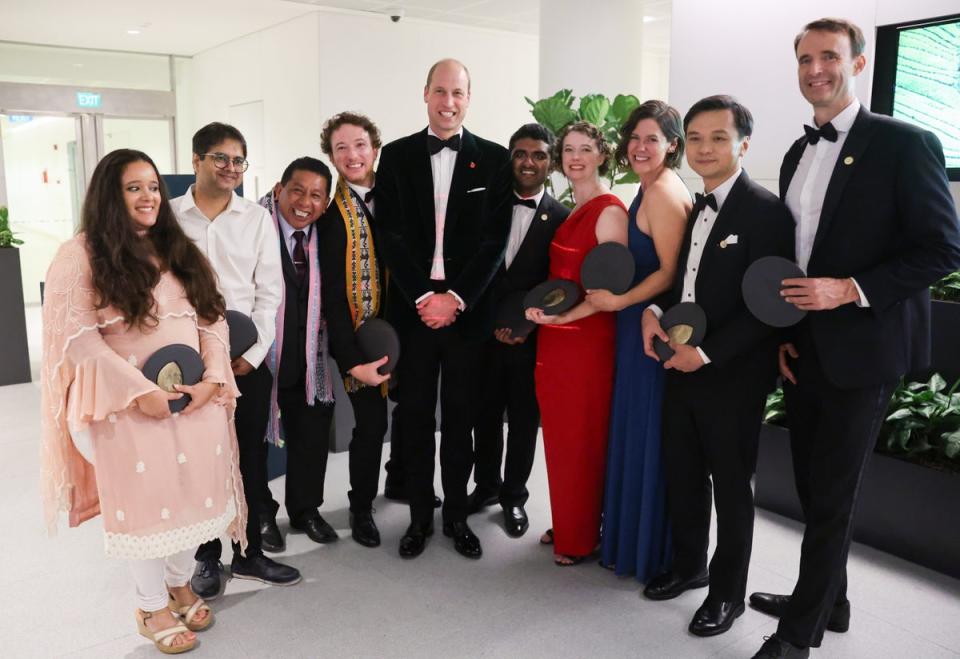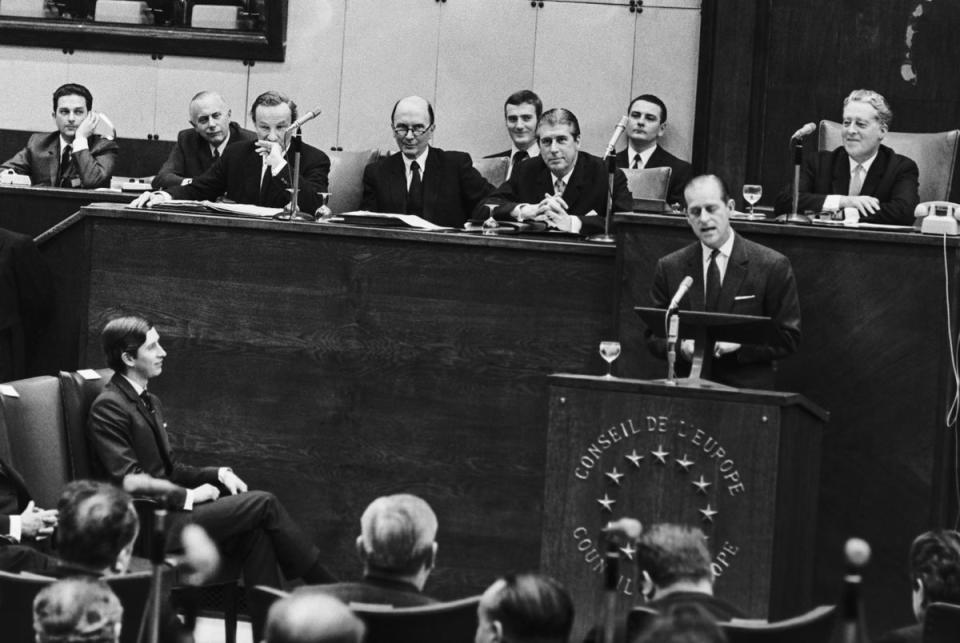Could Prince William’s battle to save the planet end the war of the Windsors?

As he stepped onto the stage on Tuesday night to present the Earthshot Prize, the Prince of Wales wore his eco-credentials on his sleeve. Quite literally. Joined by Hannah Waddingham and Cate Blanchett for the glittering ceremony in Singapore, Prince William handed out five £1m prizes to green innovators and entrepreneurs while wearing the same green velvet Alexander McQueen jacket he wore to the first Earthshot Prize in 2021 – a jacket he has owned for 10 years.
It was the kind of attention to detail that his wife, the Princess of Wales, may well have advised him on – having earned eco-fashion points earlier this year for re-wearing a one-shoulder gown, again by Alexander McQueen, for the Baftas, having first worn it to the event in 2019.
The environmental movement has gripped the royal family for more than 60 years – ever since committed conservationist Prince Philip nailed his green colours to the mast as a young man. In a ceremony that was beamed across the world, his grandson picked up the baton and made an impassioned speech, noting: “The last year has been one of great change and even greater challenge. A year in which the effects of the climate crisis have become too visible to be ignored.” But knowing that the royals are there to unite, rather than divide, he ended on an upbeat note: “We hold on to the most powerful motivators of all – optimism, and hope.”
Earthshot isn’t the only shot in his green locker. William also founded United for Wildlife, an organisation that fights against the trafficking of illegal wildlife products. He is patron of the Tusk Trust for African conservation, the British Trust for Ornithology, and Fauna & Flora International. But as the royals are finding, what began as an “easy” win is becoming increasingly tricky to navigate as the politics around green issues become more complicated.

While King Charles has long been known for his passion for sustainability, with many seeing him as the first “climate king”, he had to put on a poker face on Tuesday when it was his duty to announce the plans for Rishi Sunak’s U-turn on net zero. Without a flicker of irritation, the King said: “This bill will support the future licensing of new oil and gas fields, helping the country to transition to net zero by 2050 without adding undue burdens on households.”
Still, at least Charles can take some consolation from the prime minister’s decision to allow him to give the opening address at the Cop28 summit in the UAE at the end of this month – a year after the King was advised by Liz Truss’s government not to attend the previous summit in Egypt. He can also hold his head up high that he was one of the first British landowners to embrace the organic movement – which is now mainstream, but was once considered a dotty rich man’s indulgence.
The then Prince Charles seemed avant-garde in his own kind of green obsession, and was often mocked for talking to his plants. But he was ahead of his time, first addressing the effects of things like single-use plastics more than 50 years ago; many of his supposed fads now appear to have been prescient.
So there is no cynicism in the Green Windsors – they all feel it deeply, and it is striking that it is the one issue on which all the royal men – despite being vastly different in their personalities – seem able to agree. Philip became president of the World Wildlife Fund in Britain in 1961, just after it was founded, serving in the role until 1982. Between 1981 and 1996 he was the organisation’s international president. He wrote several environmental books, including Wildlife Crisis in 1970. David Attenborough noted, “His importance to conservation worldwide has been absolutely huge.”
William acknowledged the debt to his grandfather in his 2020 climate change documentary, A Planet for Us All, saying: “My grandfather and my father have been in conservation, the environmental world, for years. My grandfather’s well ahead of his time.”

Charles is said to have taken his children litter-picking during the holidays, and encouraged them to use their own platforms to promote environmental causes. Prince Harry first fell for Africa when he spent his year off in Lesotho in 2004. Since then, he has become the patron of Rhino Conservation Botswana. In 2019, with the Duchess of Sussex, he set up Travalyst, a project to encourage the tourism industry to become more sustainable. In 2022, he addressed the UN, saying: “Climate change wreaks havoc on our planet, with the most vulnerable suffering most of all.”
Of course, the biggest challenge for every member of the royal family is dealing with the charge of “hypocrisy”. How can the royals, who undertake frequent journeys by private plane and have a penchant for Range Rovers, stand on their eco-podiums and preach down to the rest of us? While there is no denying that the Sussexes feel a genuine passion for the environment, they reportedly still used a private jet this week to fly the short distance from their California home to a Katy Perry concert in Las Vegas.
William does his best to practise what he preaches, often flying economy and using trains rather than cars. At the inaugural Earthshot Prize ceremony in London, he and Princess Kate made a statement by arriving at the ceremony in a fully electric Audi. Similarly, Charles is known for owning an Aston Martin that runs on the by-products of wine and cheese manufacturing. Solar panels have also been installed on royal estate properties to generate electricity.
In his customary forthright manner, Philip wanted to do much more than whinge about the environment. In 1970, he told the Conference on World Pollution: “It’s totally useless for a lot of well-meaning people to wring their hands in conference and to point out the dangers of pollution, or the destruction of the countryside, if no one is willing or capable of taking any action.”

He classed himself as a practical conservationist in his role as ranger of Windsor Great Park (now one of the King’s jobs) and remained in favour of blood sports throughout his life. There is a difference between “being concerned for the conservation of nature and being a bunny-hugger”, he famously said.
While Harry is said to have given up hunting out of respect for Meghan’s beliefs about animal cruelty, it continues to be a political football for the wider royal family. As does the issue of rewilding, with Princess Anne saying this week that she wasn’t sure “rewilding at scale is necessarily a good idea” as she marked the 30th anniversary of a wildlife conservation charity she has backed for 24 years. Her point was that while rewilding – the process of allowing an area to return to a wilder or more natural state – sounds good on paper, getting the balance right in practice can be delicate. The princess said her issue at home is ragwort, which lots of people think is “absolutely brilliant because butterflies love it, but it’s not good for horses – it is, in fact, toxic”.
Equally, the King’s views on onshore wind turbines are known not to be favourable: he is reported to have described them in the past as a “horrendous blot on the landscape”.
Of course, the royal family has to jettison any activity that could compromise its neutrality. In this sense, Charles was mightily influenced by his late mother, the Queen. During more than 70 years on the throne, she never put a foot wrong on neutrality – though she made the occasional guarded, highly considered comment, such as her suggestion prior to the 2014 referendum on Scottish independence that voters should “think very carefully about the future”.
Green issues, though, aren’t going anywhere. Because of their inherent virtue, they are above princely squabbling – the Sussexes couldn’t risk for a moment making the assertion, as some have done, that William has stolen Harry’s green crown. However, the political arguments over the environment are likely to snowball. They are already leading to political conflict – net zero fans vs voters who want cheaper energy; low-traffic-zone zealots vs people who want to get to work on time.
But for the most part, the royals have chosen their environmental sweet spot: to concentrate on green solutions, as William did this week with the Earthshot Prize. Rather than asking their subjects to don hair shirts and ditch their cars, they are deploying soft power to inspire, motivate, and offer hope.
King Charles wants to protect the planet for future generations – a passion he highlighted during the six decades he spent as monarch-in-waiting. The tragic split between William and Harry seems to be terminal. But could a green dove be the answer to the war of the princes? It’s the one issue where they can win hearts and minds without getting into trouble with politics, the public – and, maybe, each other.
Harry Mount is the author of ‘How England Made the English’ (Penguin)


